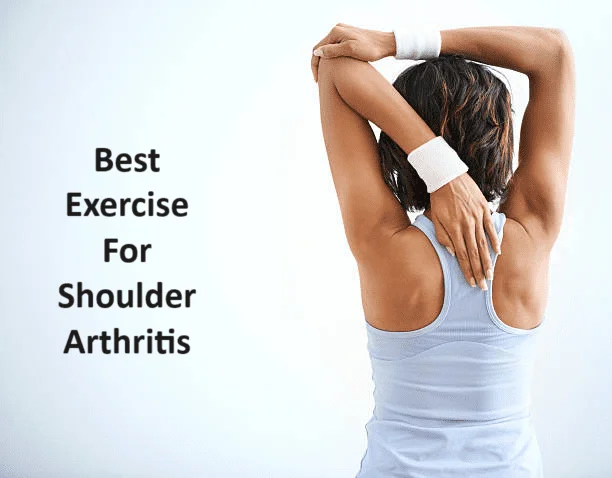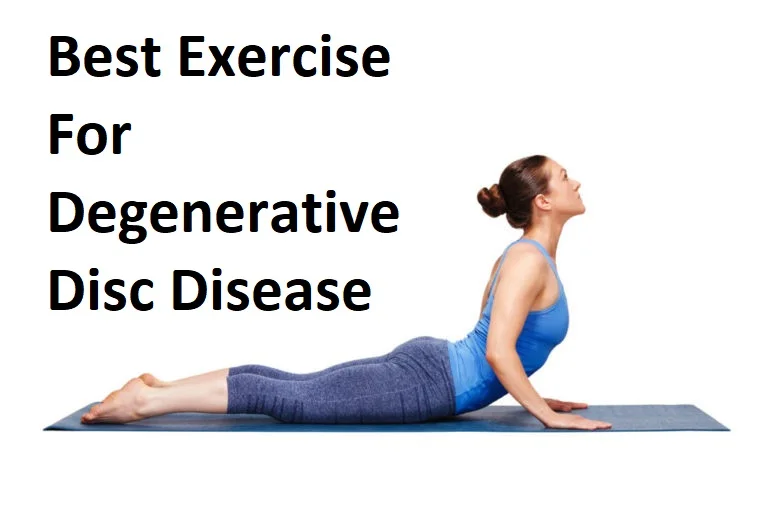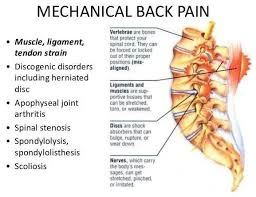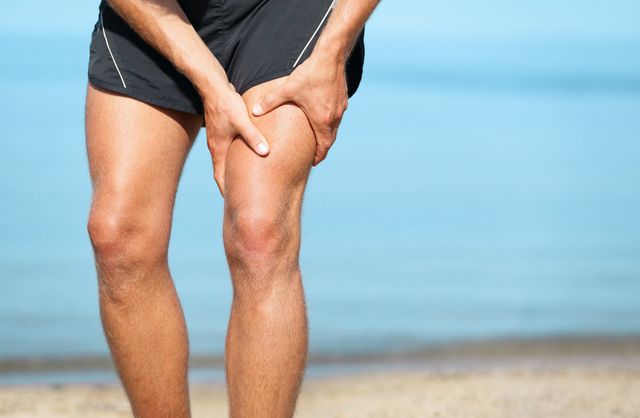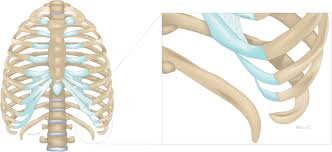24 Best Exercise For Shoulder Arthritis
Table of Contents
Introduction of shoulder arthritis
Shoulder arthritis can be a painful and limiting condition that affects the shoulder joint, causing stiffness, discomfort, and reduced mobility. Engaging in the right exercises can help manage symptoms and improve the overall function of the shoulder joint. In this guide, we will explore the best exercises for shoulder arthritis, focusing on activities that can help alleviate pain, increase range of motion, and strengthen the muscles around the shoulder to provide better support and stability.
After the hip and knee, the shoulder is the third most common form of arthritis that can occur because for most people it is not a weight-bearing joint like the large joints of the lower limbs. However, as with the hip and knee joints, the cartilage loss characteristic of shoulder arthritis often results in severe pain, limited function, joint stiffness, and a significant decrease in quality of life. Although there is no cure for arthritis, there are many treatments, both non-surgical and surgical, that help manage symptoms well and allow patients to maintain an active lifestyle.
Arthritis word comes from the Greek language “arthron” which means joint. “Itis” probably comes from Latin and refers to inflammation. Although arthritis literally means “inflamed joint”, it refers to any joint disease in which the smooth cartilage that covers the moving surface of a joint (chondral cartilage) is damaged, eventually leading to cartilage loss. in the final stage, leading to “bone-to-bone” joint surfaces and pain.
How does shoulder arthritis develop?
Arthritis of the shoulder joint is usually caused by the gradual wear and tear of the cartilage. Cartilage is present in every joint of the body; it covers the surface of the bones within the joints in the same way as ball-bearing Teflon does. Cartilage is a living tissue that is two-three millimeters thick – about the thickness of one or two layers of cardboard. This makes the contact between the bones softer. If the cartilage is healthy, it can be rotated several times without wearing the surface because it is smooth.
Four stages of shoulder arthritis
Shoulder arthritis usually develops in stages. First, the cartilage softens
(A), then cracks are created on its surface
(B), then it begins to “vibrate” (weak and shake)
(C) and finally wear away, exposing the surface of the bone
(D ). related to this stage there is a lack of smooth movement of the shoulder joint.
Cartilage does not wear away from the entire surface of the bone in a joint. Instead, it wears out at different rates in different parts. So if you consider the surface of the ball bearing that was covered with Teflon, this type of wear would be like the holes in the teflon and the surface would now be irregular.
If the surface becomes irregular, further damage to the cartilage can occur.
This can begin to thin, eventually leading to the shoulder bones rubbing against each other (four stages of cartilage loss). Many people think of arthritis as bone-to-bone contact in a joint, but arthritis is actually a process that can lead to bone-to-bone contact.
It is impossible to tell how quickly shoulder arthritis will worsen. Each person has varying degrees of cartilage damage in the shoulder joint. Usually, when certain activities cause pain, it means that the cartilage is experiencing stress. In general, the more painful the activity, the more likely it is to further damage the cartilage and shoulder joint.
How shoulder arthritis is diagnosed
The first sign of shoulder arthritis is pain in the general area, although the type and duration of pain can vary. For example, some people may feel a deep pain in the shoulder joint, while others may feel a radiating pain around the neck. A limited range of motion is another symptom of worsening shoulder arthritis.
There is the same investigation for the shoulder arthritis condition:
X-rays: X-rays show the condition of the bones in the shoulder. They can’t directly show the cartilage, but your provider can see the space between the shoulder blades. Being very close or touching means you have lost cartilage.
Computed tomography (CT): This test provides more detail about the bones in your shoulder joint than an X-ray and is often ordered to help plan surgery.
Magnetic resonance imaging (MRI): This test shows the soft tissues surrounding your shoulder joint. Your provider may order this to look at the condition of the rotator cuff tendons.
Causes of shoulder arthritis
There are many possible causes of shoulder arthritis. They include:
Osteoarthritis: after a certain age this is mostly seen in patients. After a certain age people is suffering from this condition cause of workload or lifestyle. Cartilage softens, cracks, crumbles, or eventually wears away. This exposes the bones under the cartilage, which begin to rub or grind against each other. Like the tires on your car, treads do not wear evenly or at the same rate.
Rheumatoid arthritis: This is an autoimmune disease, which means your body’s immune system attacks its own healthy tissues. With rheumatoid arthritis in your shoulder, your immune system attacks the joint and synovium, causing the lining to swell. this condition damages the cartilage of the bone.
Rotator cuff tear arthropathy: The rotator cuff is a group of four muscles that are situated around your shoulder joint and provide stability to the shoulder as the “ball” of your upper arm rotates at the base of your shoulder blades during movement. A tear in these tendons (rotator) usually occurs slowly as wear and tear over time. In some cases, these tears can slowly grow so large over time that the head of the humerus slips out of its normal position and rubs against other bones in the humerus, causing cartilage wear and arthritis.
Shoulder trauma: Any injury to the bones of the shoulder, including a dislocation, fracture, or major blow, can damage the surface of the cartilage.
Avascular necrosis: This condition, also called osteonecrosis, is the death of the “ball” part of the shoulder. Trauma or disease cuts off blood flow to the bones. Without bone support, the cartilage is damaged and eventually the shoulder joint breaks.
Shoulder Arthritis Symptoms
The magnitude of cartilage loss varies from person to person, as do the symptoms of shoulder arthritis:
Pain in the shoulder joint is the most important symptom of arthritis. It can be on the front, side, or back of the shoulder. Some people have pain even when they are not using their arm, and others only have pain when they are using it. Arthritis pain can occur at any time of the day and can occur with or without shoulder stiffness. Pain often worsens when lifting, carrying heavy objects, or after exercise. The pain can often radiate down the arm or, if severe, into the elbow and wrist. Joint stiffness is another sign of shoulder arthritis progression. You may experience stiffness such as loss of shoulder range of motion. As movement decreases, you may find that you can do fewer things with your hand, and those activities may be limited by pain.
Grinding, clicking, or cracking (crepitus) may be felt because the surface of the cartilage is irregular due to arthritis. It may or may not be painful. Sometimes the shoulder can “lock”. Because the surfaces are no longer smooth, you can sometimes feel the shoulder slip in certain positions.
Limited range of motion. Restricted movement is another common symptom. Lifting your arm to comb your hair or reach a shelf can be more difficult. Other symptoms may include stiffness, difficulty using the arm (even for normal tasks), and trouble sleeping. The degree of arthritis pain and functional impact can vary from mild to debilitating.
Loss or lack of sleep: it is difficult to find a comfortable sleeping position. any moves of the shoulder aggravated or increased the pain of the shoulder. If you sleep on your back, place a pillow under the elbow of the affected side. This will help keep your shoulders in a more familiar position. It also takes the stress off some supporting structures. For some people, sleeping in a recliner can help relieve pain at night.
This type of exercise is beneficial for shoulder arthritis and includes:
Mobility exercises increase the range of motion and flexibility exercises such as stretches reduce stiffness and provide pain relief for tight muscles.
strengthing exercises that increase the muscle endurance around the joints, reducing their tension
aerobic activities such as walking, swimming, and cycling, as they improve heart, lung, and muscle function
The following exercises increase mobility, increase flexibility, and increase the strength of the muscles of the shoulder joint.
Exercise For shoulder arthritis
Shoulder Elevation Stretches
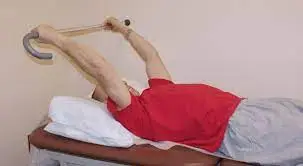
This is a great exercise to increase the upward movement of the shoulders if done consistently. However, this requires a light broom or measuring stick.
Lie on the ground, grab the measuring stick with both hands, and let it rest on your legs with your arms fully extended. Start slowly, keeping your elbows straight as you raise the bar until your hands are perpendicular to the ground. Then raise your arms above your head until you feel a nice stretch.
If possible, continue until your hands almost touch the ground above your head. Slowly lower the barbell back to your feet, again keeping your arms as straight as possible. You can repeat this up to ten times for three sets a day.
Shoulder stretches can help relieve muscle tension, pain, and tension in the neck and shoulders. Neck stretches, shoulder rolls and various yoga poses can help reduce stiffness and increase flexibility. cause of arthritos you feel discomfort in shoulder movement and limit a person’s range of movement of the shoulder.
Pendulum exercise
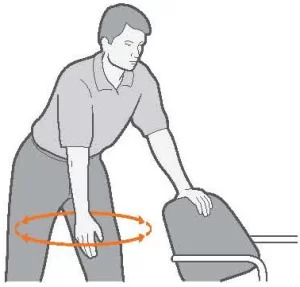
Improving flexibility can reduce pain. Stretching exercises can also help increase the pain-free range of motion. Breathe normally during exercise. And try to use smooth, flowing movements. Follow the special instructions given to you. If you feel pain, stop the exercise. If you feel the after stopping the exercise, you can apply heat on the painful area. there is the whole procedure for the pendulum exercise. If necessary, ask the physiotherapist to demonstrate the exercise.
Lean on a table or chair with your good hand. you can choose the sitting or standing position for the pendulum exercise. Ask your physiotherapist which position works best for you. then relax your shoulder and do shoulder adduction for the relaxation. Begin swinging the relaxed arm slowly. Move it in a small circle and gradually increase it if possible. Then reverse direction. Then, move it back and forth. then you move in the abduction and adduction direction of the shoulder joint.
Chest expansion
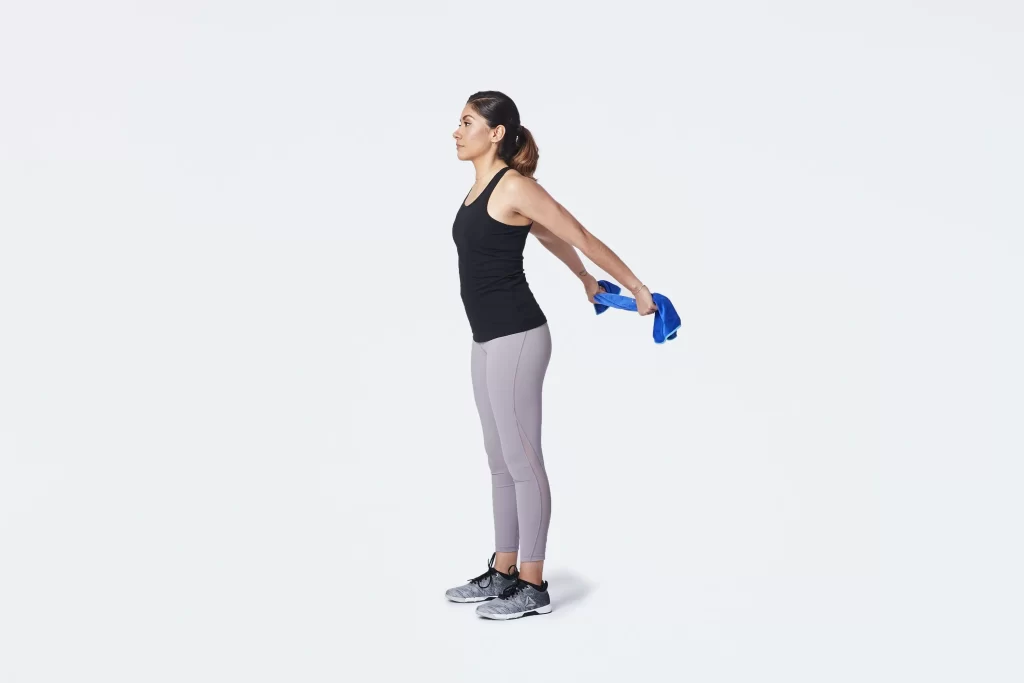
Chest expansion is a good way to stretch your back muscles, open your chest, and increase your shoulder range of motion. It can also help expand your lungs to take in more oxygen, Snyder says. Here’s how to do this stretch.
Stand tall with your feet together. Hold the end of a towel or exercise band in both hands, hands behind your body. Use a towel or band to move the shoulders together and open the chest. It makes you look at the ceiling. Hold the stretch for around five to ten seconds gradually you can increase the duration of the hold.
Repeat three to five times per session and do three to four sets per day.
Standing arm swings
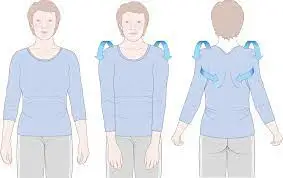
The standing arm swing is the best dynamic exercise which helps increase blood flow to the shoulder joint. Doing this exercise as part of a warm-up before performing upper body exercises can improve the mobility and flexibility of the shoulder and upper back.
To do this exercise:
Stand tall with your arms at your sides. Brace your core and push your arms forward until they are as high as possible. Make sure you don’t shrug your shoulders. Return your shoulders to the starting position(original position) and repeat. Do this shoulder movement(flexion and extension) for 30-60 seconds.
Shoulder pass-through
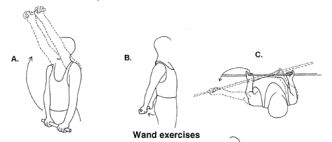
The shoulder roll exercise helps increase joint mobility while engaging the muscles surrounding the shoulder. This exercise requires you to hold a long stick, such as a broom or a PVC pipe.
To do this exercise:
Stand with your feet shoulder-width apart and your hands in front of your body. Hold onto a stick such as a brush handle or a PVC pipe with a handle. Hands are wider than shoulder width. Make sure the pole or tube is parallel to the floor. Engage the core and slowly raise the brush handle or tube above your head, keeping your arms straight. Go as comfortable as possible. Hold the position for a few seconds. Return to the starting position. Do ten repetitions per session and do three sets per day.
Table slide exercise
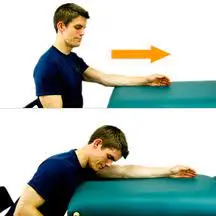
This is an assisted active range of motion that focuses on improving shoulder abduction. Begin by sitting next to a table with your shoulders at a 90-degree angle to the edge, and hands on the table. Bend to the side, sliding your arms straight to your side. The rotary cuff can be turned on by pressing down with your hand as it slides out – easier with a towel under the arm. Maintain pressure as you slide your arm back and return to a vertical position. If placing your palms on the table is uncomfortable, place them facing each other for this exercise. The advantage of the skateboard training is that it increases the shoulder joint.
You can do 10-15 times per session and do three to five sets per day.
Shoulder pulley
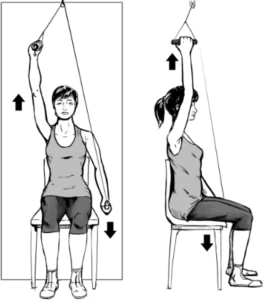
The shoulder rope and pulley exercise is a way to comfortably stretch and increase the range of motion of both the shoulder joint and the rotator cuff. Attach the shoulder pulley to the door and sit on the chair directly under the pulley.
Hold both ends of the pulley in your hands, palms facing each other.
Use your “good” hand to guide the stiff arm up by pulling the handle down to and over the knee.
Raise your stiff arm as high above your head as possible and hold it. Keep your outstretched arms as relaxed as possible at all times.
Hold for five to ten seconds in the upper range of each movement. Do ten repetitions per session and do three to five sets. You can use the pulley to move the arm straight up, sideways, or some combination in between. If you don’t have a pulley, you can also try a standing pendulum push using a stick or even a yoga ball for a controlled movement.
Scapular squeeze with arm lift
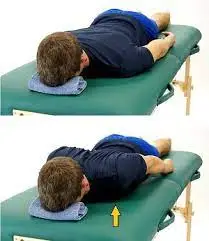
Start from your stomach on a plinth or mat, head on a towel (for support and comfort, you can keep a napkin or towel under your forehead), and keep both shoulders in an anatomical position. Insert the scapula into the scapula by pressing it. Hold this position, raise your arm and hand about two to three cm.
Hold the position, then lower your arms and hands, and finally relax the scapular pressure. Repeat Four to ten times with the goal of holding for 30 seconds. Make sure your shoulders don’t fall forward – use your lower traps to brace your chest. Strengthening the muscles between the shoulder blades with exercises such as shoulder presses can make everyday activities easier and more comfortable, such as: Sitting up straight. It is important to know that there is no such thing as an ideal position.
Scapular Retractions “W” Position
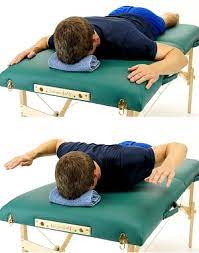
Start with the prone lying on a plinth or mat. for convenience, a napkin should be kept under the forehead. Pull your shoulders back and down, let your elbows rise, but now keep your hands on the bed. It feels completely different than the hands-on side. Then raise your arms so that your forearms are parallel to the bed, hold, and then lower. Aim for 30 seconds, five to ten repetitions. Keep your shoulders down and toward your spine, don’t let your shoulder drop.
This exercise strengthens the shoulder muscles. Resistance band rows work the same muscles as rows on other equipment. the mechanics of the movements are the same as your back muscles (i.e. glutes, traps, rhombuses), back muscles, and arms (especially biceps and forearms).
While the progression
a. Hold a weight or can in your hand for the strength
Resistance Band Rows
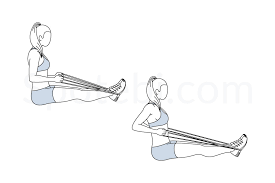
For the resistance band exercise, take a standing position and then attach the resistance band to a stable object, such as a doorknob, and hold it with both hands. As you pull your shoulders back and down, pull the strap back and let your elbows bend. Hold for three to five seconds and slowly bring your arms forward, holding both boxes back as long as possible. Keep your elbows close to your body at all times while the exercise which provides stability.
You can do five to ten times per session and do three sets per day.
Variations
Bent Over Rows
Bent Over Alt Rows
Kroc Rows (aka Single Arm Rows)
Upright Rows
Seated Neutral-Grip Row (anchored)
Seated Single Arm Row (anchored)
Seated Lat Pulldown (anchored)
Chest Openings With Band
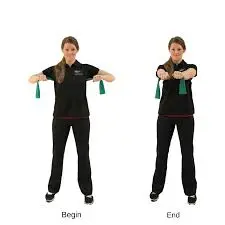
For the chest opening with resistance band exercise, you can take a sitting or standing position. you have to arrange a resistance band according to your strength. then Hold the band in front of your chest, and keep your elbows straight.
Pull your arms out to the side, pulling your chest back and down.
Hold for three to five seconds and slowly bring your hands together.
Progression: Press your arms in and out while holding the pose.
Variations
Different stabilizing muscles of the shoulder can be strengthened by changing the position of the hand, e.g. palm up, palm down, palm in, palm out.
Shoulder internal rotation
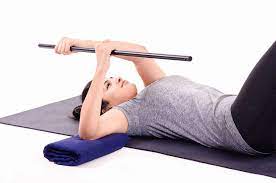
Shoulder internal rotation exercises can performed as strengthening exercises which can help make your injured shoulder more stable. start the exercise with movement then you can add the resistance band for the strength of the muscles.
To warm up, first do flexibility (stretching) exercises. Your healthcare provider will tell you what size dumbbells to use for strengthening exercises. If you don’t have dumbbells, try using soup bowls instead:
Lie on a firm surface with your knees bent. Pick up the weight using the hand on the same side as the injured shoulder. Bend this arm at right angles (90 degrees). You can use a rubber band for this exercise. Tie the ends of the ribbon together to form a three-foot loop. Attach the tape to a fixed object, such as a closed doorknob. Stand by the door, hold the strap at your elbow, and close to your body. Slowly move your hand to your stomach. Hold the pain-free range of movement around five to ten seconds and you should gradually increase the duration of hold. and then back to the starting position of the movement.
Shoulder external rotation
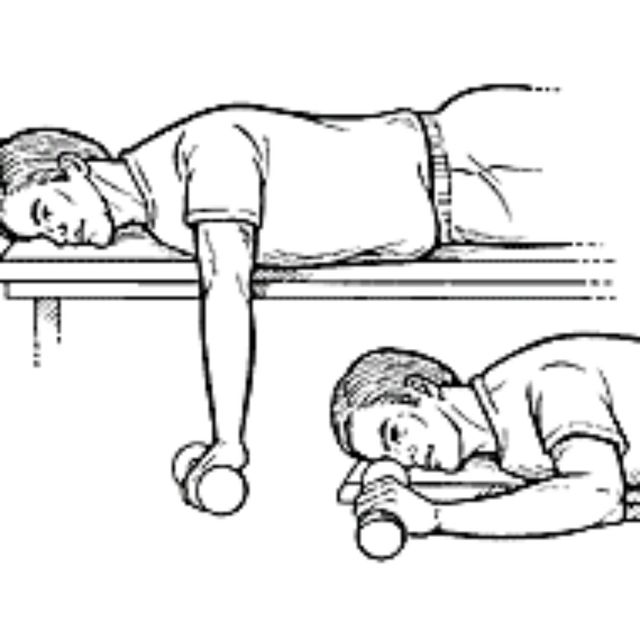
Isometric shoulder external rotation is an exercise that helps strengthen the rotator cuff muscles, especially the teres minor and infraspinatus. To complete the exercise:
Continue to stand perpendicular to the wall about six inches away from it. The shoulder you are training is closest to the wall. Bend your elbow 90 degrees, make a fist, and press the back of your hand against the wall as if you were turning your arm outward. If necessary, use a small towel as a pillow. Press lightly against the wall for about five seconds.
Slowly release the pressure on the wall. Stop the exercise if you feel that the pain is increasing. Do 10-15 repetitions per session and do three sets per day.
For the starting periods of exercise only you can do a movement after that during the progression duration you can add the resistance band for the strengthening of the muscle.
Isometric Shoulder Abduction
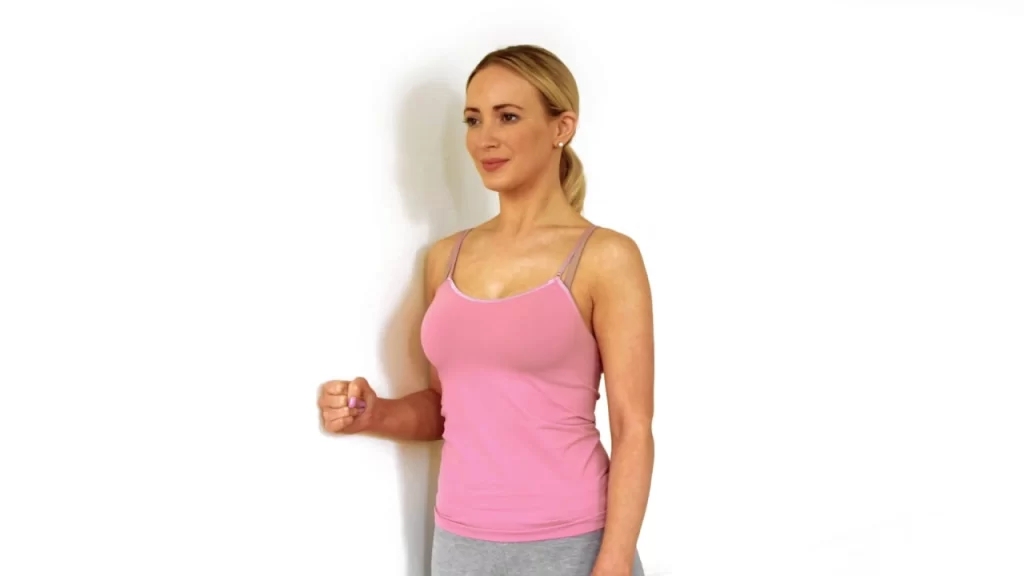
Isometric exercise is an exercise in which certain muscles are contracted without other movements. A physical therapist may prescribe isometric shoulder exercises if you have pain or need to restore normal range of motion, strength, and/or mobility to your shoulder. Performing isometric shoulder abduction exercises:
Stand about six inches from the wall, but turn your body so that it is perpendicular to the wall. The shoulder you want to train should be close to the wall. Make a fist and press it against the wall. If you want, you can use a folded towel for added comfort. Press lightly against the wall as if you were trying to raise your arm to the side and hold it there for five seconds. Slowly release the pressure on the wall. Again, no need to push the wall; light pressure will do.
Do eight to ten repetitions per session and do three sets per day. then move on to the next exercise designed to work the rotator cuff muscles.
Isometric Shoulder Extension
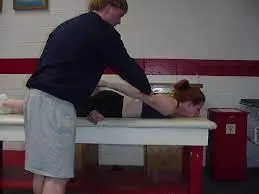
Isometric exercise is an exercise in which certain muscles are contracted without other movements. A physical therapist may prescribe isometric shoulder exercises if you have pain or need to restore normal range of motion, strength, and/or mobility to your shoulder. To do an isometric shoulder extension:
Stand about six inches from the wall with your back to it. Keep your elbow straight so that your hand is close to your hip. Take a fist and gently press it against the wall behind you. There should be very little movement in the shoulder. hold the resistance of the wall or physiotherapist for around three to five seconds. and Do eight to ten repetitions. Once you begin to activate the shoulder muscles, you can progress by adding dynamic resistance band isometrics and active shoulder range of motion.
Arm Crossover Stretch
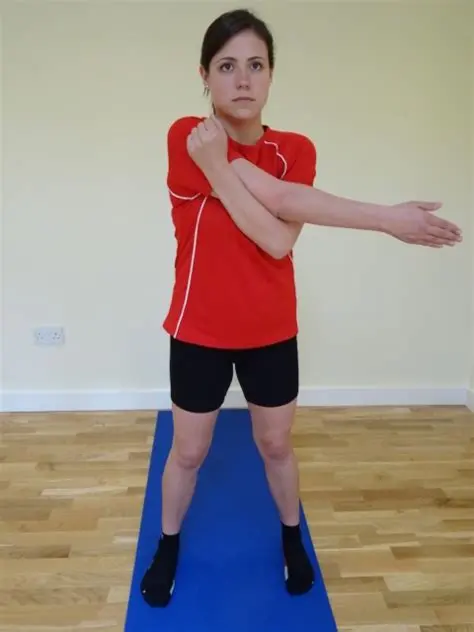
For the arm crossover stretch exercise follow the instructions below.
Start from a standing position.
With the help of one hand, grasp the posterior aspect of the forearm and then arm across the body. Press your arms into your body to feel more tension. Hold for 30 seconds. Repeat with the other hand. Make sure your elbows stay at shoulder level during the stretch.
Now you have learned how to do the Cross Body Raise.
A common mistake is to cross your arms with a shrug. Its purpose is to stretch and warm the upper back, not contract. Instead, keep your shoulders down as you do these push-ups in a good, high position
The Cross-Body Shoulder Stretch primarily targets the Infraspinatus, Teres Minor, and Posterior Deltoid muscles, but also activates the following muscles:
Trapezius
Latissimus Dorsi
Rhomboids
Wall sliding
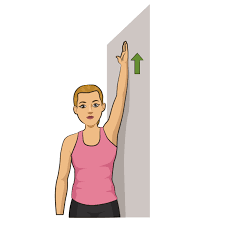
Wall slides help increase strength and flexibility in the shoulders and upper back. It helps you sit and stand and perform activities such as lifting and reaching overhead. It also helps maintain upper body stability and activates the heart, helping you stay balanced in your daily activities.
Stand with your arms at shoulder height and press your hands against the wall in front of you to round your upper back. The fingers should point up and the pink side of the hand should touch the wall, palms facing each other.
Slide your arms up toward the ceiling while gently pressing your hands against the wall. Hold this position at the top, and continue to press gently against the wall.
Slide your hands down the wall to return to the starting position.
You should feel the shoulder, arm, and upper back muscles working with each repetition.
During the progression, you can add a resistance band between your hands to add resistance – keeping a little tension in the band. Everyone is different, so you may need to modify the sliding wall cabinets to suit your needs. Repeat the movement eight to ten times per session and Do three sets per day.
Towel shoulder strech
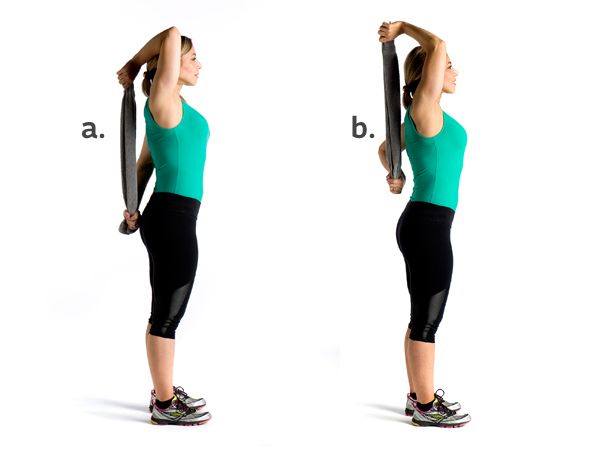
The towel shoulder stretch is a great exercise to help improve shoulder flexibility and range of motion. It’s actually a combination of three movements around the shoulder: internal rotation, adduction (moving the shoulder closer to the body), and extension. Get a long towel, like a bath or beach towel. You can also use a long strap or your own belt. Hold the towel in one hand and spread it over your shoulder and back. When you extend your right shoulder, the towel should be placed on your left shoulder and held in your left hand. With your other hand, reach behind you and grab the towel.
Gently pull the towel up and let your hands move up and behind your back. There should be a gentle stretch on the front or side of the shoulder. If you feel a stretch in your shoulder, hold the position for two or three seconds, then slowly release the stretch. Repeat 10 times, trying to pull your arm up your back each time. Remember to move slowly and avoid sudden or jerky movements.
Remember that you should feel a gentle stretch or pull around the shoulder joint during the internal rotation stretch. It should not cause pain. If you experience persistent shoulder pain after stretching, contact your healthcare.
Lateral raise exercise
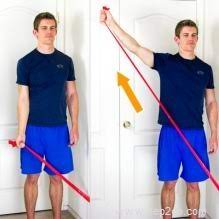
The lateral raise exercise specifically targets the deltoid muscle of the shoulder and provides strength to this muscle. If done regularly, it can help you develop stronger, broader shoulders. the lateral raise exercise specifically considered the deltoid muscles. All you need is a pair of light dumbbells and enough shoulder flexibility to abduct your arms (lift the weights out and away from your body) until they form a T shape with your shoulders. start with the standing position and keep dumbbells in both hands. Place your feet about hip-width apart.
Check your posture – roll your shoulders back, brace your core, and look straight ahead. At the same time, raise your arms just a few inches to either side and pause. This momentary pause should help ensure that you release the trapezius muscles from the movement and engage the deltoids as intended.
Lift the dumbbells up and out on both sides, keeping your arms almost completely straight, stopping when your elbows are at shoulder level and your body forms a T shape. Inhale while lifting. At the end of the movement hold the position for around five to ten seconds. Lower the weights slowly (lowering the weights takes about twice as long as lifting them) returning your arms to your sides. Exhale as you lower the dumbbells.
Wall slide with a foam roller
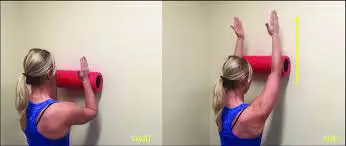
Stand facing a wall with your feet shoulder-width apart or step one foot out slightly. Place your forearms on the wall at shoulder height with your thumbs facing you. This is the important part: extending the shoulders to activate the serratus anterior muscle. To do this, press your forearms against the wall and consider pushing your upper back away from the wall by keeping your forearms on the wall, or consider joining the shoulders in front. Pull your chest down as you tighten your abs. This is the starting position. Maintain this extended position and slowly slide your arms down the wall as far as possible. Just go up as much as possible to maintain a high position. it will increase the range of the shoulder and then back to the starting position of the movement.
Scaption exercise
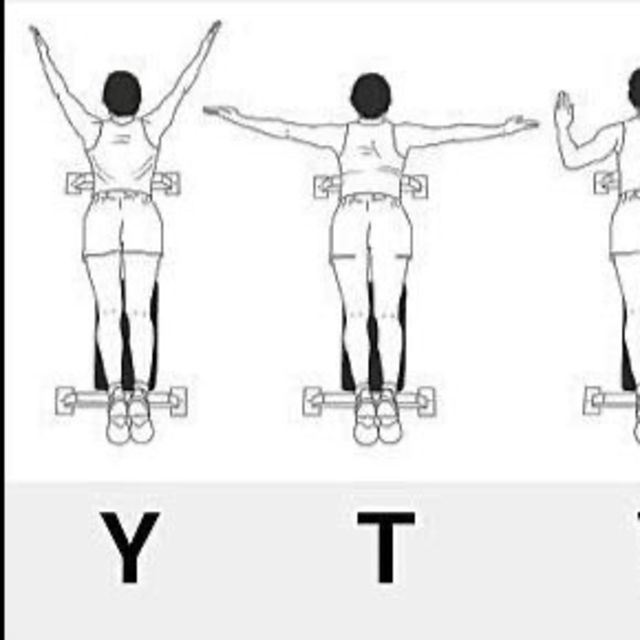
Starting position: Lie (stomach) on the mat, arms and legs fully extended. Point your toes away from your body and fully extend your elbows and fingers with your palms facing inward. To stiffen (“support”) the abdominal muscles to stabilize the spine, squeeze and pull the scapula (pull the shoulders back and down) and try to maintain these positions during the exercise. Align the head with the thoracic (upper) spine.
“T” shape:
Exhale gently from the same starting position slowly lift your arms off the floor and move your arms into a T shape (90-degree angle to form a T) as shown, palms facing forward. maintained the alignment with the head of your thoracic (upper) spine. Focus most of the lift through the shoulders, not the lower back, although some extension (arching) of the lower back is acceptable. Hold this position for five to ten seconds, then relax and return to the starting position. Do two to four repetitions.
“Y” shape:
Exhale gently from the same starting position slowly lift your arms off the floor and move your hands into a Y shape (45-degree angle to form a Y) as described, palms facing inward. maintained the alignment with the head of your thoracic (upper) spine. Focus most of the lift through the shoulders, not the lower back, although some extension (arching) of the lower back is acceptable. Hold this position for five to ten seconds, then relax and return to the starting position. Do two to four repetitions.
Bench press exercise
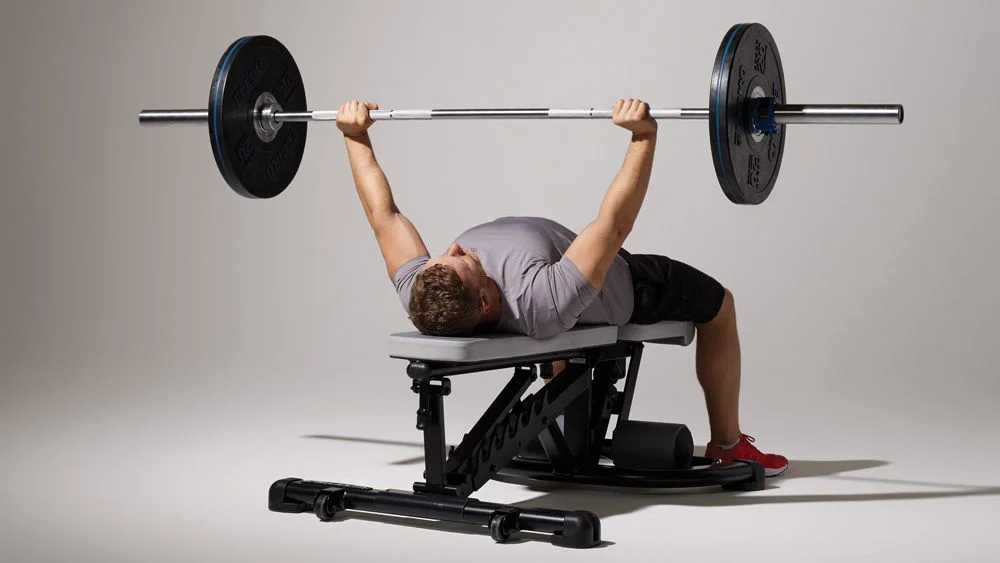
The bench press exercise considered the muscles of the upper body. This involves lying on a bench and pressing a weight up with a barbell or dumbbell. During the bench press, you lower the weight to chest level and then push up while extending the arms. This movement is considered one repetition. Necessary equipment: barbell (extra weights optional) or dumbbells, flat bench
Lie on your back on a flat bench. The band should be directly above the shoulders. Press your feet firmly into the ground and keep your hips on the bench throughout the movement. maintained the neutral spine position during the exercise. Avoid arching your back. If you use dumbbells or barbells, slowly raise them. Lower the bar to your chest at about nipple level, allowing your elbows to bend out to the side, about 45 degrees away from your body. Stop counting when your elbows are under the bench. Press your feet into the surface as you push the bar back to the starting position. Do five to ten repetitions depending on the weight you are using. Complete up to two to three sets per day.
Wall Press Ups
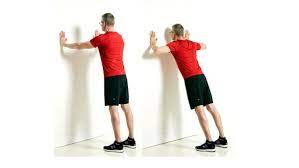
Stand facing the wall and raise your arms forward with straight elbows so that your hands just touch the wall.
Keep your both palms on the wall at approximately shoulder height, and all the fingers in the extension position. If you feel like you are reaching too far, gradually move towards the wall. Slowly do elbow extension and begin to lean your body towards the wall until your nose touches the wall. Keep your back straight and your elbows bent at about a 45-degree angle (not straight out to the sides). Gradually back to the starting position.
when you press against the wall you should never lean your back toward the wall. The wall press targets upper body muscles such as the chest, arms, and shoulders as a mobilizer. The main muscles used in wall pressing are: the chest muscles (e.g., the pectoralis major and pectoralis minor), the serratus anterior, the triceps, the deltoids, the upper, middle, and lower back muscles (e.g., the trapezius and rhomboids, as well as the spinal muscles), the core muscles (e.g., the transversus abdominis, multifidus, obliques, and rectus abdominis)
Variations on the wall pushup
Close hands wall pushup
One-arm wall pushup
One-leg wall pushup
Feet on the wall pushup
Face pull
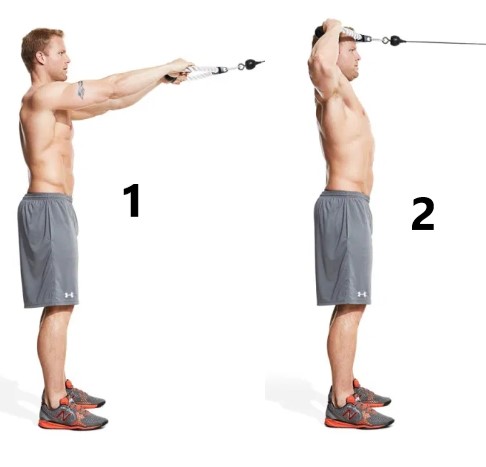
The starting position is standing, holding a cable holder in both hands, palms facing each other and thumbs turned. Begin pulling the rope with your elbows leading your hands as you pull back, and squeeze your glutes as you finish the movement. For Cable Face Pulls, we start by placing the cable attachment in a high position on the cable, or if you practice at home, you can anchor the band to something high. Take the ends of the string with your thumbs backward. Keep your elbows under your shoulders. You don’t want to raise them to the level of your shoulders.
Then you turn your hand slightly and pull. By turning in and out, you achieve external rotation of the shoulder to hit the rotator cuff, which most normal exercise programs never do. Facelifts are one of the best corrective exercises to help correct poor posture and shoulder dysfunction. They help strengthen our chronically weak upper body muscles that are strained all day while we sit at the computer or drive.
There are many shoulder muscle involvements during this exercise(Posterior deltoid (rear delts)
Mid Trapezius,Lower Trapezius,Infraspinatus,Teres Major).
Aerobic Exercise for Shoulder Arthritis
Because the shoulder does not bear weight like the knees and hips, people with shoulder arthritis can walk, jog, and use aerobic exercise equipment such as treadmills.
For patients with moderate to severe shoulder pain and stiffness, it may be best to avoid aerobic exercise that involves the use of the shoulder, such as the elliptical or swimming.
For patients with more advanced symptoms, swimming may be too difficult, but they can try water aerobics or other water exercises. For most, hydrotherapy (pool therapy) is tolerable, providing aerobic health benefits without putting too much strain on the shoulder.
Exercising in water offers benefits such as:
Buoyancy with the support of water reduces the pressure on the joints
Resistance that requires the muscles to work harder to move (e.g., walking in waist-deep water is more difficult than walking on land).
Shoulder Arthritis Treatment
Range of motion exercises
The first form of treatment for shoulder arthritis is medical (non-surgical) treatment. It often begins with a range of motion exercises for the shoulder. If your motion isn’t affected, the goal is to prevent it from getting worse. Loss of movement in the shoulder joint caused by arthritis is often gradual and can be difficult to detect. As the joint stiffens, pain and activity may also worsen. It is recommended to stretch for 2-3 minutes every day, regardless of whether the movement is impaired or not.
Physical therapy for shoulder arthritis is usually not necessary unless you lose range of motion. Stimulating shoulders with arthritis is generally not recommended, as it can cause more pain in some cases. However, if the exercises do not bother the shoulder, they are perfectly suitable.
Lifestyle changes
Another treatment method is to avoid things that hurt the shoulder. In general, anything that causes pain should be avoided, especially if the pain is interfering with your life. If shoulder pain persists for several days and wakes you up at night, it may be wise to question how important activity is to you. For example, if you have pain while playing golf, you may need to reduce it to once a week instead of every day.
Pain management
A third treatment is to try to control the pain. there are many ways to treat or decrease the pain of shoulder arthritis condition:
Cryotherapy is the best option for pain management. Ice packs are good for pain and can be used once or more a day if needed. You can use an ice pack or cold therapy that can be put in the freezer and reused. The ice pack should be placed in front of, across, and behind the shoulder. the duration for the cryotherapy minimum of 15 to 20 minutes. If pain wakes you up at night, consider icing your shoulder before bed.
Some people believe that heat is a better treatment for shoulder arthritis. Heat therapy you can use before the exercise which provides relaxation to your muscles. Medications can also be used to relieve pain, but each has its own benefits and potential complications. Discuss your medications with your primary care physician or surgeon to make sure there is no reason for you to avoid certain medications.
What medications can be used for shoulder arthritis?
You can start with acetaminophen because it has few side effects. However, it can affect the liver when used in high doses, so consult your doctor about the best dose. The next group of drugs that help shoulder arthritis symptoms are called non-steroidal anti-inflammatory drugs (NSAIDs). Most NSAIDs can be taken only for pain, providing relief when needed.
If you need continuous pain relief, consult your doctor. You should also not use NSAIDs if you have a history of bleeding and ulcers, take blood thinners, have kidney failure, certain heart conditions, or other medical conditions. Discuss these concerns with your doctor before taking NSAIDs.
Injections for Shoulder Arthritis
Currently, there are two types of injections for shoulder arthritis pain relief. The first type is cortisone injections. Cortisone is usually mixed with a numbing agent that provides immediate pain relief and helps the doctor know if the injection is in the right place. When the anesthesia wears off, the joint may hurt until the cortisone takes effect. It is important that the shoulder remains frozen for about a day after the injection.
Cortisone injections do not harm the shoulder, but most surgeons limit them to more than a few years in most cases of arthritis. Cortisone injections may increase the risk of infection if you have total shoulder surgery shortly after the injection. If you are considering surgery, consider avoiding cortisone injections for a few months.
It’s essential to consult with a healthcare professional or physical therapist before starting any exercise program to ensure it is tailored to your specific needs and condition. With proper guidance and a consistent exercise routine, you can work towards maintaining a healthier, more functional shoulder despite arthritis.
Surgical treatment
Shoulder surgery
If other treatments do not relieve your pain and your arthritis worsens, surgery may be an option. Common surgical options include:
Total shoulder replacement surgery: In this surgery, plastic and metal replace the diseased bone parts of your shoulder joint. The surgeon removes part of the “ball” of the head of the humerus. It was replaced with a new metal head that attaches to a metal stem inside your humerus. A smooth plastic heel covers the shoulder bag.
Rotary shoulder replacement surgery: In this surgery, your surgeon will reposition the ball and socket. The metal head attaches to the scapula and the slot to the humerus.
Arthroscopic shoulder debridement: In this surgery, small tools and a camera are inserted through small incisions into the shoulder. A surgeon will remove any loose pieces of damaged cartilage from your shoulder joint. They also file bone spurs (if any). This may be an option if you have early arthritis and the cartilage is still there. Although this procedure does not stop arthritis, pain relief can last up to 24 months.
Resection arthroplasty surgery: This is the most common surgery for arthritis of the acromioclavicular (AC) joint. During this surgery, your surgeon removes a small amount of bone from the end of the collarbone. The space between the collarbone and shoulder blades is full of scar tissue. The surgeon can consider variations of these main types of surgery based on the type, location, and severity of the arthritis.
Avoid while exercising
It is important to avoid exercises that strain or put excessive pressure on the shoulder muscles, as this can lead to injury.
Certain stretches can be painful or uncomfortable for some people and not for others, so it’s very important to listen to your body when exercising.
For some people, shoulder exercises such as push-ups or lifting heavy weights can be too intense for the shoulder joint. However, light exercise is essential for building shoulder muscles.
Aerobic exercise is also important for physical health and mental well-being.
Those who suffer from severe symptoms can try gentle alternatives to conventional forms of exercise, such as replacing swimming with hydrotherapy. This form of exercise offers many of the same benefits as swimming but puts less pressure on the shoulders. Some people with milder symptoms can continue with traditional aerobic exercise.
The most appropriate type or frequency of exercise varies from person to person. This depends on the severity of the person’s arthritis symptoms and other factors, such as the amount of muscle around the affected joints.
A physical therapist should be able to work with the individual to create a customized exercise plan for them and explain specific exercises they should avoid.
Risk factors of shoulder arthritis
It occurs more often in people over 50 years of age.
Occurs in younger people with rheumatoid arthritis or after a shoulder injury such as a shoulder fracture, shoulder dislocation, or infection.
Can shoulder arthritis be prevented?
In general, you can reduce your chances of developing arthritis by:
Avoiding tobacco products. If you use tobacco products, your provider can give you advice on how to quit smoking and information about support services.
Doing low-impact, weight-free exercise. Maintain a healthy weight. follow a healthy diet, such as balanced food. Reduces the risk of joint injuries.
Avoid or limit movement that puts much pressure on your shoulder at risk of injury. Contact your doctor at the first symptoms. If your shoulder problem is caught early, you can learn how to reduce pain, modify or avoid certain activities, and reduce cartilage damage.
Benefits of Shoulder Exercises
Stretching and strengthening combined with aerobic exercise can provide a number of benefits, including:
Reduces pain.
Exercise strengthens muscles, and stronger muscles support better joints. One risk of shoulder arthritis is that a person avoids activities that cause pain or discomfort and cause shoulder muscle atrophy. By strengthening the muscles surrounding the shoulder, including the muscles that stabilize the rotator cuff and scapula, the glenohumeral joint of the shoulder becomes more stable. This stability can help prevent bones from moving and protect bones from impact and friction, reducing pain.
Increases mobility and function.
Shoulder pain can prevent a person from being active, which combines the problem of joint pain with stiffness, which causes pain to increase. Regular exercise helps keep the shoulder joint and surrounding muscles in shape, which increases shoulder function.
Supports healthy cartilage.
Articular cartilage needs movement and a certain amount of stress to stay healthy. Synovial fluid is deposited in the cartilage like water in a sponge. When the joint is in use, synovial fluid is secreted by the cartilage, which provides the joint with nutrients and lubrication. Synovial fluid is also thought to promote a joint healing environment that reduces inflammation and supports healthy joint function.
Helps to lose weight.
Exercise combined with a nutritious, low-fat diet can help you lose weight. Although weight loss is not as important for people with shoulder arthritis as it is for people with arthritis in weight-bearing joints such as the knee, losing weight can improve overall health and mobility, making shoulder arthritis more manageable.
Help maintain the function.
Chronic shoulder pain can prevent a person from performing daily tasks or participating in sports and recreational activities. Limitations in daily activities can be frustrating and sometimes depressing. Exercise—along with possibly physical modifications—can help people with shoulder arthritis return to many of the activities they love and participate in their daily routines.
Preparing for Shoulder Exercises
A person should always work with a health care provider to develop an exercise plan that meets their specific needs and physical challenges. A well-tailored warm-up and post-workout routine will help maximize the benefits of stretching, strengthening, and training, and minimize the potential for soreness or injury.
Warm-up:
All exercise routines should usually be preceded by a 10-minute warm-up, which increases circulation and literally warms up the body, making the muscles more flexible. Walking or other slow aerobic activity warms the body. For those with more severe arthritis, gentle movement and a warm compress may be enough.
Post-workout:
After exercise, some people may need to ice their shoulders (a bag of frozen peas) and/or take an over-the-counter NSAID (e.g. Advil, Aleve) to reduce swelling and discomfort.
If you experience pain during shoulder exercise, stop and seek advice from a health professional or qualified sports trainer before continuing.
Home remedies for the shoulder arthritis condition
Aquatic exercises
Aquatic exercise can be beneficial for people with shoulder arthritis. Water provides resistance, which helps increase the intensity of the exercise. At the same time, the buoyancy provided by the water helps to support the weight of the body, reducing the pressure on the joints. To relieve persistent pain, researchers support current recommendations of 40 to 60 minutes of aquatic exercise three times a week. The aquatic exercise program has experienced the following benefits:
reduced body fat
improved coordination
improved range of motion
improved mood and quality of life
Weight loss
Losing weight can reduce pressure on joints and reduce pain and stiffness.
Tai chi
Tai chi is an example of low-impact exercise which includes slow or mild movements to improve the flexibility, muscle strength, and balance of muscles. that a 12-week course of tai chi helped reduce pain and stiffness and increase physical activity in patients with osteoarthritis.
Yoga
Compared to a control group, participants practicing yoga reported significant improvements in health, mood, quality of life, and ability to cope with chronic pain.
Hot and cold treatment
Heat and cold therapy are two different but effective ways to reduce arthritis pain.
Heat therapy increases circulation and can relieve stiff joints and sore muscles, while cold therapy constricts blood vessels, which slows blood flow, reduces swelling, and numbs pain. People can alternate between hot and cold, but it is important to carefully check the skin for damage from these treatments and stop using them if there is an injury.
heat treatment includes:
Start the day with a warm bath or shower to relieve stiffness
by applying warm paraffin wax to painful joints
placing a heating pad or hot water bottle on painful joints
Massage
Massage also helps improve mood by increasing serotonin levels. A trained therapist massaged each participant once a week for 4 weeks. The patient can also learn one or two massage techniques so they can get a massage at home by themselves.
Transcutaneous electrical nerve stimulation (TENS)
TENS is a method of pain relief that uses electrodes in the form of sticky pads that adhere to the surface of the skin to deliver small electrical currents to the body.
Vitamin D
Vitamin D strengthens bones and helps maintain the function of the immune system.
Safety Considerations
Remember that these exercises are meant to relieve pain, not cause it. You should experience a mild stretch or comfortable tension while exercising, but not discomfort. If any of these exercises cause pain, reduce the number of repetitions or try less extreme movements.
If you find that your pain worsens after any of these exercises and an ice pack or non-steroidal anti-inflammatory drug (NSAID) does not effectively relieve the pain, you should see your doctor.
A note from Samarpan Physiotherapy Clinic
Shoulder arthritis can be painful and affect your quality of life. Although there is no cure for arthritis, there are many ways to ease the pain. You can use cryotherapy, heat therapy, and exercises(mobility, stretching, and strengthening) to keep your shoulder flexible and comfortable. Also, limit or avoid activities that aggravate your pain. If these simple methods do not relieve your pain, ask your doctor about surgical options. Seeing your provider is the first step in determining the cause of your shoulder pain and developing a treatment plan that can best relieve your symptoms.
FAQ
Arthritis of the shoulder joint
Symptoms of shoulder arthritis can include shoulder pain, stiffness, and reduced range of motion. There are many non-surgical treatments for shoulder arthritis, including stretches, lifestyle changes, the use of ice or heat, and medications to relieve pain.
Shoulder Arthritis: Types, Treatment, Surgery | HSS
However, as with the hip and knee, the cartilage loss characteristic of shoulder arthritis is often a source of severe pain, limited function, joint stiffness, and a significant decrease in quality of life.
There is no cure for arthritis. Physiotherapy can help keep joints working by decreasing pain and inflammation through exercise and some modalities. focused on a treatment plan with your physiotherapist and doctor that includes medicine and therapy. focused on lifestyle changes that can improve your quality of life.
It can start quite slowly and then gradually get worse or start more aggressively. Rheumatoid arthritis can affect adults of all ages. It most often begins between the ages of 40 and 60 years.
If you have arthritis, participating in joint-friendly physical activity can improve arthritis pain, function, mood, and quality of life. Joint-friendly physical activities are low-impact, meaning they reduce body weight and reduce the risk of injury.
References
- DiGiacinto, J. (2021, September 30). 5 Types of Shoulder Arthritis. Health line. https://www.healthline.com/health/osteoarthritis/shoulder-arthritis-types#diagnosis
- Shoulder Arthritis. (2023, March 21). Johns Hopkins Medicine. https://www.hopkinsmedicine.org/health/conditions-and-diseases/shoulder-arthritis
- Professional, C. C. M. (n.d.). Shoulder Arthritis. Cleveland Clinic. https://my.clevelandclinic.org/health/diseases/22491-shoulder-arthritis
- Shoulder Arthritis. (2023, March 21). Johns Hopkins Medicine. https://www.hopkinsmedicine.org/health/conditions-and-diseases/shoulder-arthritis
- Exercises for Shoulder Flexibility: Pendulum Exercise. (n.d.). Saint Luke’s Health System. https://www.saintlukeskc.org/health-library/exercises-shoulder-flexibility-pendulum-exercise
- Lindberg, S. (2020, January 10). 10 Shoulder Mobility Exercises and Stretches. Healthline. https://www.healthline.com/health/shoulder-mobility-exercises#exercises
- & S. Z. K. (2023, June 13). Exercise Tutorial: Cross Body Shoulder Stretch. Your House Fitness. https://www.yourhousefitness.com/blog/exercise-tutorial-cross-body-shoulder-stretch
- Cooper, G. (n.d.). Shoulder Exercises for Arthritis. Arthritis-health. https://www.arthritis-health.com/treatment/exercise/shoulder-exercises-arthritis
- Pt, B. S. (2022, May 13). The Towel Shoulder Rotation Stretch. Verywell Health. https://www.verywellhealth.com/the-towel-shoulder-rotation-stretch-2696336
- Cooper, G. (n.d.). Shoulder Strengthening Exercises. Arthritis-health. https://www.arthritis-health.com/treatment/exercise/shoulder-strengthening-exercises
- Back Exercises | Prone Scapular (Shoulder) Stabilization Series – I, Y, T, W, O Formation. (n.d.). https://www.acefitness.org/resources/everyone/exercise-library/249/prone-scapular-shoulder-stabilization-series-i-y-t-w-o-formation/
- 15 Scapular Stabilization Exercises: Shoulder Pain Explained. (n.d.). Shoulder-Pain-Explained.com. https://www.shoulder-pain-explained.com/scapular-stabilization-exercises.html
- Lillis, C. (2019, February 14). The best home remedies for arthritis. https://www.medicalnewstoday.com/articles/324446#vitamin-d
- Song, D. (2022, March 6). Shoulder Abduction Table Slide — Rehab Hero. Rehab Hero. https://rehabhero.ca/exercise/shoulder-abduction-table-slide
- Arthritis in Shoulder Exercises – Where to Start. (n.d.). Vive Health. https://www.vivehealth.com/blogs/resources/arthritis-in-shoulder-exercises

